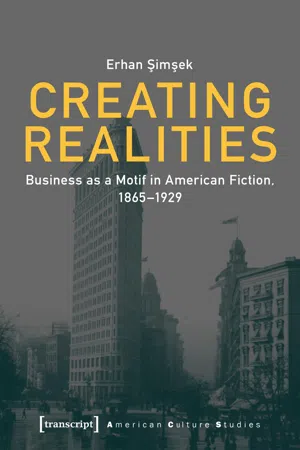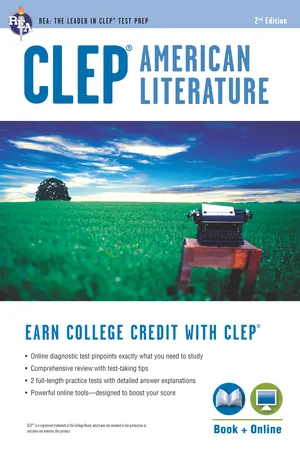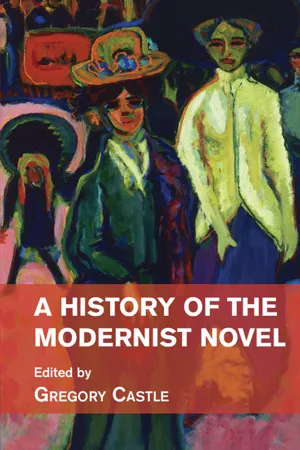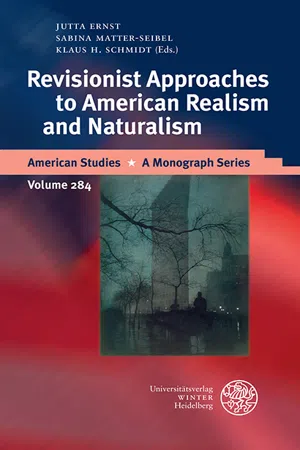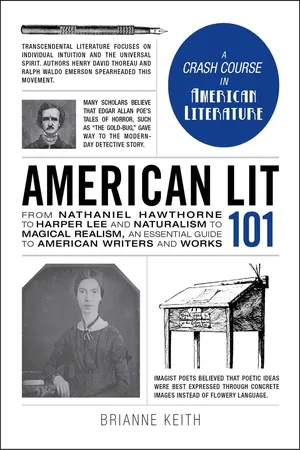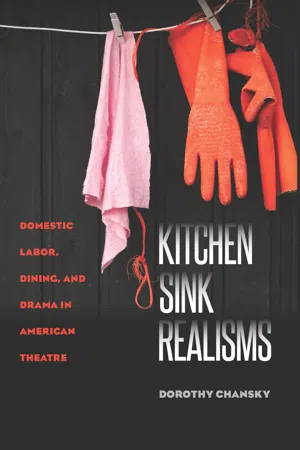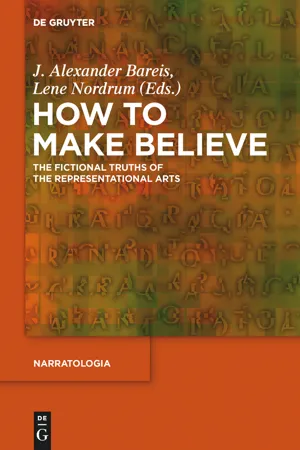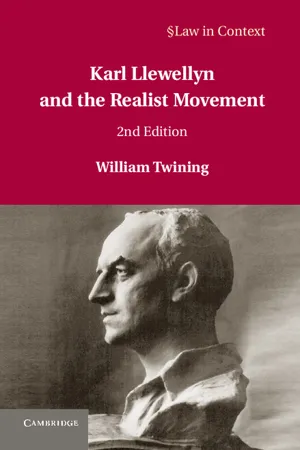Literature
American Realism
American Realism in literature refers to a movement that emerged in the late 19th century, focusing on depicting everyday life and its struggles with a sense of objectivity and truth. Writers such as Mark Twain and Henry James sought to portray the complexities of human experience and society, often addressing social issues and the impact of industrialization on American life.
Written by Perlego with AI-assistance
Related key terms
1 of 5
9 Key excerpts on "American Realism"
- eBook - PDF
Creating Realities
Business as a Motif in American Fiction, 1865–1929
- Erhan Simsek(Author)
- 2019(Publication Date)
- transcript Verlag(Publisher)
First of all, we locate American Realism within the existing literature. 4 Re-search into American Realism can be roughly divided into two phases. Before the 4 Early definitions of rea lism in the arts included “an approach that attempts to describe life without idealization or romantic subjectivity” ( Columbia ). Another dictionary de-fines the term as a word “used as vaguely as ‘naturalism,’ implying a desire to depict things accurately a nd objectively” ( Chilvers and Glaves-Smith 588). For the OED , the term implies “a concern with accurate and objective representation.” One other diction-ary offers the following definition: “Realism, term applied to literary composition that aims at an interpretation of the actualities of any aspect of life, free from subjective prejudice, idealism, or romantic color” (Hart and Leininger 552). In other words, ob-jectivity, or the lack of subjectivity, has been the key tenet of realist art for a variety of scholars and institutions. However, these definitions not only take the literary text as a Business in American Romance and Realism | 61 poststructural turn in the late 1970s and early 1980s, scholars held to a more ref-erential understanding of the movement. Following Vernon Louis Parrington, scholars such as Richard Chase, Warner Berthoff and Donald Pizer thought that American realists objectively registered “the i ndustrialization of America under the leadership of the middle class ” (Parrington xxvi). Alfred Kazin reiterates a similar idea by saying, “Our modern literature in America [i.e., American Realism] is at bottom only the expression of our modern life in America” ( On Native Grounds xxii). Behind these statements lies the assumption that literature was a referential medium and American Realism mirrored social and political realities in particular. In fact, this mimetic attitude paved the way for early critics’ preference of American romance over realism as the “more American literature. - eBook - ePub
- Jacob Stratman(Author)
- 2016(Publication Date)
- Research & Education Association(Publisher)
Chapter 4 Realism and Naturalism (1865–1910) REALISMI am making a slight change to the dates that the College Board (creators of the CLEP tests) states in its literature. Some scholars believe that realism as a literary movement began closer to 1870, but many more scholars point to the beginning of the Civil War as the beginning of American literary realism. Bullets, bloodshed, and brotherly bickering ushered in a reality that reacted strongly to the idyllic existence American romanticism painted. Then, after the battles ended, America began to grow and to expand its urban areas at the expense of its rural areas. The Industrial Revolution and increased European immigration caused a boom in urban populations. Post–Civil War America found itself in an existence of disillusionment and cynicism. Major technological breakthroughs also occurred at the end of the nineteenth century: the invention of the telephone, the completion of the transcontinental railroad, and, of course, the introduction of the automobile. So literary realism is the label we give to those works that attempt to portray life as it actually is and not simply as the writer wishes (the latter being idealism). The brief historical information just mentioned is important because those incidents influenced writers who focused their plots and characters on the very immediate happenings of people in particular cultural moments. Realism is very interested in the mundane episodes of middle-class life; therefore, realist novels tended to lean towards social reform. Also, writers took it upon themselves to critically comment on America’s politics, economics, industry, and social issues, as well as gender, class, and race issues.NaturalismLiterary naturalism is said to be a product of scientific determinism. Here’s a simple definition: You are controlled by your environment. There is no hope for you. Dreams come and dreams go. You are controlled by your gender, race, socioeconomic standing, and ethnicity. There is a glass ceiling and you will hit it every time you venture beyond your status. Depressing, huh? Yes, it is. There is more to the literary movement than that, of course. Naturalism was greatly influenced by the work of Charles Darwin, Isaac Newton, Karl Marx, and Emile Zola, and other naturalists who posited that humans are not that different from animals in that they merely respond to natural and environmental forces without fully understanding the forces or their reactions to them. What is also important about naturalist fiction is that the author and the narrator are amoral in their depictions of the characters and the plot: they do not judge or editorialize; they merely observe. - eBook - ePub
- G. R. Thompson(Author)
- 2011(Publication Date)
- Wiley-Blackwell(Publisher)
In American literature, the primary meaning of realism indicates a period: the historical era from about a decade after the American Civil War to a decade or two after World War I. 1 But literary realism, even when confined to a historical period, is not a single undiversified idea or theoretical program or movement. In both Britain and America, major fictional forms partaking of both realism and romance included the domestic novel, the novel of manners, and the sentimental novel. In America there was an important, predominantly realist, movement toward regionalism, within which broad rubric a form called local color is sometimes distinguished. Both centrally involve a forceful vernacular style (idiomatic spoken language), often in dialect (regional or ethnic idiom). In addition, we can identify, at the minimum, several forms of realist theory and practice in Europe and America: objective realism, compassionate realism, benevolent realism, and sentimental realism. There is also a distinction to be made between intense “social reformist” realism and “quiet” realism. Variations on realism and anti-romance are also in tension with, or in complementary relation to, impressionism and expressionism and most especially naturalism. 2 “The Way Things Happen”: Henry James on the Art of Fiction One of the most celebrated theoretical distinctions between realism and romance, or more precisely between the realistic novel and the romance, is found in the preface to the revised edition (1907) of James's The American (1877), in which he declares that the essence of realist fiction as distinguished from romance is the representation of “our general sense of ‘the way things happen.’” The concept embedded in James's phrase is more complicated than it sounds. His “definition” involves a perceived difference between the novel and the romance that he had discounted two decades earlier - eBook - PDF
- Gregory Castle(Author)
- 2015(Publication Date)
- Cambridge University Press(Publisher)
While beyond the scope of this chapter, the emerging emphasis on various conceptions of the real in the early twentieth century deserves mention as a historical backdrop that helps to position literary realism as part of a prevailing cultural concern with validating the bona fide as distinct from the counterfeit, the imitative, or the overly embellished. In accordance with this cultural preoccupation, and despite sophisticated literary-critical acknowledgments that realism as a genre is, of course, not a mirroring of reality but a set of rhetorical conventions, there were widespread assumptions that it was some- how less affected, and hence less alienated from actual experience, than elite modernisms. (Writing for the Colored American Magazine in 1916, Katherine Williams excoriated “‘literary gem[s]’” that “suit the high-brows,” and vowed to use “plain, commonsense language, so that the masses may read and understand.” 3 ) Standard definitions American Literary Realism 171 of literary realism stress such notions as plausibility and verisimili- tude, and its common techniques include the use of “natural” verna- cular and close attention to physical detail; it also posits the quotidian as worthy of extended consideration. Hence despite its conventions, literary realism avoids aspects of expression or plot, including those typical of high modernism or sensationalism, that may be perceived as heightened, extreme, or excessively convoluted – that is, not “true” to actual life. Further contributing to the accepted sense of literary realism as reflecting a real world was its typical subject matter. The classic nineteenth-century realism of William Dean Howells was closely identi fied with the bourgeois experience that was his theme; that particular relationship between form and substance persisted well into the twentieth century and helped to consolidate realism’s conceptual alignment with the actual. - No longer available |Learn more
- Jutta Ernst, Sabina Matter-Seibel, Klaus H. Schmidt(Authors)
- 2018(Publication Date)
- Universitätsverlag Winter(Publisher)
Introduction The present collection has evolved from a symposium hosted by the American Studies division of Johannes Gutenberg University Mainz, Germersheim campus. The symposium was meant to be a reaction to a paradoxical phenomenon in American literary studies: on the one hand, academic conferences and special journal issues on this subject are few and far between 1 —a strange absence emphasized in Winfried Fluck’s opening statement that “[r]ealism can be called a stepchild of American literary history,” alluding to the fact that realist modes of representation have frequently been out of sync with dominant schools of criticism. On the other hand, specialists in the field have generated an enormous body of innovative publications, with new book series such as “Studies in American Literary Realism and Naturalism” (2000–), 2 or long-standing editing projects such as “The Dreiser Edition” (1981–), 3 spawning more than 50 volumes in the past four decades. That the core period of U.S. realism and naturalism has made a comeback in Americanist research appears to echo a widespread obsession with ‘authenticity’ and ‘the real’ 1 For the last special issues published in Amerikastudien/American Studies , see Ickstadt and Hornung, guest eds., Strained Relations: American Realism and the Domestic Novel (1991); as well as Claviez and Moss, guest eds., Neorealism—Between Innovation and Continuation (2004). 2 For most recent titles in the “Studies in American Literary Realism and Nat-uralism” series (ed. Scharnhorst), see N. Williams, Gears and God (2018); Bergman, ed., Charlotte Perkins Gilman (2017); Elbert and Ryden, eds., Haunting Realities (2017); Polley, Echoes of Emerson (2017); Wonham and Howe, eds., Mark Twain and Money (2017); Bush, Continuing Bonds with the Dead (2016); and Kiskis, Mark Twain at Home (2016). 3 To date, “The Dreiser Edition” has brought forth 18 volumes under the roof of three publishers (see Works Cited). - eBook - ePub
American Lit 101
From Nathaniel Hawthorne to Harper Lee and Naturalism to Magical Realism, an essential guide to American writers and works
- Brianne Keith(Author)
- 2017(Publication Date)
- Adams Media(Publisher)
Chapter 5
Realism and Naturalism
In the decades after the Civil War, America was faced with the enormous task of rebuilding itself. The Civil War cost the nation more than 600,000 lives—that’s more American casualties than in both World Wars, the Korean War, and the Vietnam War combined. After a period of prosperity, the country was now in debt. After a period of idealism, the country was now morally exhausted.A brighter future was ahead, though. Even though the war was costly, it spurred a burst of technological and economic growth that moved the country forward. The first transcontinental railroad, the mass expansion of electricity into people’s homes, and the invention of the telephone connected people in unprecedented ways. Huge deposits of coal, oil, iron, gold, and silver drew people west where they became rich. The country was on its way to becoming the richest nation in the world.But while the nation was expanding economically, it was retracting spiritually and intellectually. People were beginning to take a hard, cold look at American ideals that drove them to war, especially in the face of disappointing Reconstruction policies that failed to live up to the war’s promise of granting blacks equal rights. A new form of literature called realism developed that represented what America really looked and sounded like. Writers such as Mark Twain sought to represent matters truthfully, stripped of the pretenses of romanticism.Moreover, Charles Darwin’s new theory of natural selection was radically changing peoples’ ideas of their place in nature. The “best of us” may have gotten there by virtue of “survival of the fittest,” not by God’s “special appointment” as Puritans thought. America was on the verge of a huge industrial explosion, with plenty of opportunities to become rich—and plenty of opportunities to fall into poverty and despair. Thousands of immigrants poured into the nation and into the hungry jaws of robber barons ready to exploit them. As a result, a new field of literature opened up called naturalism. Writers such as Stephen Crane and Jack London looked at humans’ relationship to nature and saw beings caught in an indifferent universe. Writers like Henry James and Edith Wharton looked at the individual’s relationship to society and saw people caught in an oppressive web. People saw life as having no purpose other than survival; humans were, in many ways, a product of their society and ultimately subject to laws outside of their control. - eBook - PDF
Kitchen Sink Realisms
Domestic Labor, Dining, and Drama in American Theatre
- Dorothy Chansky(Author)
- 2015(Publication Date)
- University Of Iowa Press(Publisher)
Then recall that two of the most often studied iconographic endeavors from the 1950s are the poetry of the Beats and the film Rebel Without a Cause . One did not need to be called to testify before the House Un-American Activities Committee to see cracks in the ideological facade, nor even to have re-sistant opinions on some subjects. Theatre is different from literature in that theatre proceeds on simultaneous, multiple tracks, all of which are available to the audi-ence, and does so in real time. Hence, realism in the theatre is not just the product of the text. In historicizing the late nineteenth-century ad-vent of realism as America’s favorite genre, Brenda Murphy notes that innovations in plays emerged after innovations in stagecraft, mean-ing that the hyperrealistic mise-en-scène (settings, props, costumes, physical arrangements) preceded the earliest recognized realistic play texts by nearly a generation. Murphy uses an inverted and slightly re-labeled version of Aristotle’s criteria for tragedy to name the features that American playwrights worked with to write dramas falling under the rubric realism. The category “stagecraft”—roughly analogous to spectacle—was sixth of six for Aristotle, first for emerging realist play-wrights. American playwrights began to stipulate and comment on 8 I N T R O D U C T I O N detailed settings with the idea that these were not just decoration or backdrop but were important to understanding character and theme. Playwrights also expected actors to bring to life specific, individu-ated characters, and to facilitate this, they provided nuanced, particu-larized ways of talking that (presumably) went beyond stereotypes, with the goal of invoking specific classes, neighborhoods, ethnicities, and personalities. This commitment to verisimilitude as an ordinary way of doing business allowed audiences to trust playwrights’ intro-ducing them to new or strange milieus. - eBook - PDF
How to Make Believe
The Fictional Truths of the Representational Arts
- J. Alexander Bareis, Lene Nordrum, J. Alexander Bareis, Lene Nordrum(Authors)
- 2015(Publication Date)
- De Gruyter(Publisher)
One can falsify realist descriptions by looking and seeing if they correspond to reality: Look within and life, it seems, is very far from being ‘like this’. Examine for a moment an ordinary mind on an ordinary day. The mind receives a myriad impressions – trivial, fan-tastic, evanescent, or engraved with the sharpness of steel. (Woolf 1966, 106) The Concept of Literary Realism | 27 So, if one opens up the concept of reality as it occurs in the criterion ‘providing a truthful/objective representation of some aspect of reality’, this criterion can-not be used to distinguish between the modes of writing that literary critics have been identifying as realism and modernism. The concept of realism has then lost its usefulness as a critical concept. The attack on literary realism by post-modernist critics was part and parcel of a wider attack on humanism. An unanalysed concept of realism with its ap-parent conceptual link to reference and truth provided an easy target for critics who wanted to undermine humanist values. And the response to post-modernist critics was not really a defence of realism, but, in Gerald Graff’s (1979, 193) words, “a realist defence of humanism”. And in this struggle the concept of realism was itself a casualty. When the concept of realism is put under pressure, as it was by Lukács and post-modernist critics, it breaks, and it breaks at a very important point. A concept of realism which licences the con-clusion that modernism leads to the destruction of literature, that only naïve readers can find any satisfaction in realist literary works, or that realist novels are not really realist, or that, contrary to all empirical evidence, realism is dead, is simply useless as a critical tool. The effect of the debate between post-modernist critics and the defenders of realism was to derail any fruitful discussion of realism for thirty years. - eBook - PDF
- William Twining(Author)
- 2012(Publication Date)
- Cambridge University Press(Publisher)
The result was that from the middle of the nineteenth century up to the present day American lawyers and judges have had to cope with a body of reported cases which is so vast and varied as simply to undermine the basic rationale of a system of precedent. Thus the relative ineffectiveness of the legislatures and the unmanageability of the primary sources of law were among the factors which gave American legal scholars the opportunity to play a much more important part in their legal system than their counterparts in the British Isles. The American realist movement can be viewed as one of the response of American jurists to the problems of unification, systematization and modernization of American Law. Legal realism was, in the first instance, a product of the concerns of a number of teachers of law, nearly all of whom were based in a few leading law schools on the eastern seaboard of the United States. These concerns reflected the complex situation of American academic lawyers: as teachers they were faced with the problems of the aims, the methods and the quality of formal preparation for the practice of law; as scholars they needed to ask: What should be the functions and the scope of legal research? As intellectuals of a kind they were affected by some powerful trends in contem- porary American social and philosophical thought. As lawyers they had a dual perspective in that they were called on to identify, at least in part, with the practitioners working in the existing legal structure, while at the same time they were particularly well placed to see law in the United States as a single system, transcend- ing the boundaries of the various state and federal jurisdictions. As reformers, they were acutely conscious of a seeming lag between 8 KARL LLEWELLYN AND THE REALIST MOVEMENT legal and social change. To understand the realist movement it is important to see it in the context of these concerns.
Index pages curate the most relevant extracts from our library of academic textbooks. They’ve been created using an in-house natural language model (NLM), each adding context and meaning to key research topics.
